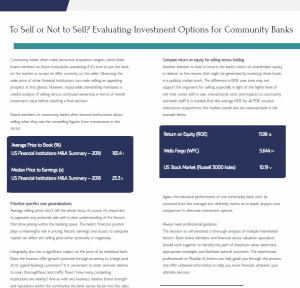Community banks often make attractive acquisition targets, which leads board members at these institutions wondering if it’s time to put the bank on the market or accept an offer currently on the table. Observing the sales price of other financial institutions can make selling an appealing prospect at first glance. However, responsible stewardship mandates a careful analysis of selling versus continued ownership in terms of overall investment value before reaching a final decision.
Board members at community banks often become enthusiastic about selling when they see compelling figures from transactions in the sector.
Prioritize specifics over-generalizations
Average selling prices don’t tell the whole story, of course. It’s important to approach any potential sale with a clear understanding of the factors that drive pricing within the banking space. The bank’s financial position plays a meaningful role in pricing; historic earnings and access to adequate capital can affect the selling price either positively or negatively.
Geography also has a significant impact on the price of an individual bank. Does the location offer growth potential through proximity to a large pool of its typical banking customers? Is it convenient to enter and exit relative to main thoroughfares and traffic flows? How many competing institutions are nearby? And as with any business, relative brand strength and reputation within the community the bank serves factor into the sales price as well.
In addition to an awareness of pricing factors, board members should adopt a realistic stance in regard to net sales revenue. Just listening to the talk at investment bank conventions can create a perception that the selling price will deliver an exceptional financial windfall. These conversations frequently omit mention of all the associated transaction costs that reduce net sales revenue. After deducting taxes and investment banker fees from the total, the price often seems less thrilling. Consider too the reinvestment and liquidity risks of taking stock in a transaction, and how the sale may affect the community and employees when assessing potential financial gain.
Compare return on equity for selling versus holding
Another element to bear in mind is the bank’s return on shareholder equity in relation to the returns that might be generated by investing these funds in a publicly-traded stock. The difference in ROE over time may not support the argument for selling, especially in light of the higher level of risk that comes with a sale, transactional costs and impacts to community and bank staff. It is notable that the average ROE for all FDIC-insured institutions outperforms the market overall and the national banks.
Again, the individual performance of one community bank can’t be surmised from the averages but definitely merits an in-depth analysis and comparison to alternate investment options.
Always seek professional guidance
The decision to sell demands a thorough analysis of multiple interrelated factors. Bank board members and financial sector valuation specialists should work together to identify the path of maximum value, determine appropriate strategies and facilitate optimal outcomes. The experienced professionals at Mauldin & Jenkins can help guide you through the process and offer unbiased information to help you move forward, whatever your ultimate decision.


